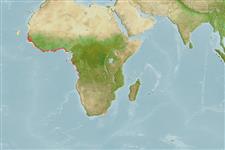ກຸ່ມປາກະດູກອ່ອນ (ເຊັ່ນ: ປາສະຫລາມ, ປາຜາໄລ) (sharks and rays) >
Myliobatiformes (Stingrays) >
Dasyatidae (Stingrays) > Urogymninae
Etymology: margaritella: Named for the smaller size of this stingray and of its pearl (Latin: margarita) spine, as compared to Dasyatis margarita (Ref. 26277).
Eponymy: Margaritella is the diminutive of Margarita and is used to show this species is smaller than its relative (see Margarita above). The vernacular name is not only used to convey ‘Little Pearl’ but to reflect the fact that this species has a pearl spine. (Ref. 128868), visit book page.
More on authors: Compagno & Roberts.
Issue
Distribution will be corrected.
Environment: milieu / climate zone / depth range / distribution range
ນິເວດວິທະຍາ
ສັດທະເລ; ນ້ຳກ່ອຍ ອາໄສຢູ່ໃກ້ໜ້າດິນໃຕ້ພື້ນທ້ອງນ້ຳ; ລະດັບຄວາມເລິກ ? - 60 m (Ref. 114953). Tropical
Eastern Central Atlantic: West African coast from Cape Blanc in Mauritania to Angola (Ref. 7397, 81259, 81625, 114953). Often confused with Dasyatis margarita (Günther, 1870) (Ref. 7397).
ຂະໜາດ / ນ້ຳໜັກ / Age
Maturity: Lm ? range ? - ? cm
Max length : 30.0 cm WD ຕົວຜູ້/ບໍ່ມີເພດ; (Ref. 81259); ນ້ຳໜັກສູງສຸດທີ່ເຄຍຈັດພີມມາ: 1.0 kg (Ref. 81259)
ສັດທີ່ມີກະດູກສັນຫຼັງ: 116 - 128. Diagnosis: Dasyatis margaritella is the smallest dasyatid in West Africa (Ref. 26277). It is most similar to Dasyatis margarita, which is larger and has a larger pearl spine, and more numerous pectoral radials, 133-135 vs. 116-127 in D. margaritella (Ref. 26277). It is also similar to D. garouaensis, which has a much flatter disc and a longer snout (Ref. 26277).
Dasyatis margaritella is the most common littoral stingray on the West African coast and it enter lagoons, shallow bays and estuaries (Ref. 7397, 81259). Most likely feeds on small invertebrates (Ref. 114953). Ovoviviparous (Ref. 50449).
Life cycle and mating behavior
ການຈະເລີນເຕັມໄວ | ການສືບພັນ | ການວາງໄຂ່ | ໄຂ່ | ຄວາມດົກຂອງໄຂ່ປາ | ຕົວອ່ອນ
Exhibit ovoviparity (aplacental viviparity), with embryos feeding initially on yolk, then receiving additional nourishment from the mother by indirect absorption of uterine fluid enriched with mucus, fat or protein through specialised structures (Ref. 50449). Distinct pairing with embrace (Ref. 205).
Séret, B., 2003. Dasyatidae. p. 81-96. In D. Paugy, C. Lévêque and G.G Teugels (eds.) The fresh and brackish water fishes of West Africa Volume 1. Collection Faune et Flore Tropicales 40. Institut de recherche de développement, Paris, France, Muséum national d'histoire naturelle, Paris, France and Musée royal de l'Afrique Central, Tervuren, Belgium, 457p. (Ref. 81259)
IUCN Red List Status (Ref. 130435: Version 2024-2)
Threat to humans
Harmless
Human uses
ເຄື່ອງມື
Special reports
Download XML
ແຫຼ່ງອີນເຕີເນັດ
Estimates based on models
Preferred temperature (Ref.
123201): 23.7 - 28, mean 26.6 °C (based on 66 cells).
Phylogenetic diversity index (Ref.
82804): PD
50 = 0.5156 [Uniqueness, from 0.5 = low to 2.0 = high].
Bayesian length-weight: a=0.01023 (0.00486 - 0.02155), b=3.06 (2.87 - 3.25), in cm total length, based on LWR estimates for this (Sub)family-body shape (Ref.
93245).
ຊັ້ນເຂດຮ້ອນ (Ref.
69278): 3.9 ±0.13 se; based on food items.
ຄວາມຢືດຢຸ່ນ (Ref.
120179): ຕຳ່, ປະຊາກອນຕຳ່ສຸດທີ່ໃຊ້ເວລາສອງເທົ່າ 4.5 - 14 ປີ (Assuming fecundity<100).
Fishing Vulnerability (Ref.
59153): Very high vulnerability (90 of 100).
Nutrients (Ref.
124155): Calcium = 63.4 [13.9, 304.2] mg/100g; Iron = 0.84 [0.21, 2.38] mg/100g; Protein = 21.7 [18.8, 24.8] %; Omega3 = 0.222 [0.061, 0.662] g/100g; Selenium = 27.6 [8.0, 80.2] μg/100g; VitaminA = 34.4 [12.4, 91.8] μg/100g; Zinc = 1.38 [0.67, 2.66] mg/100g (wet weight);
